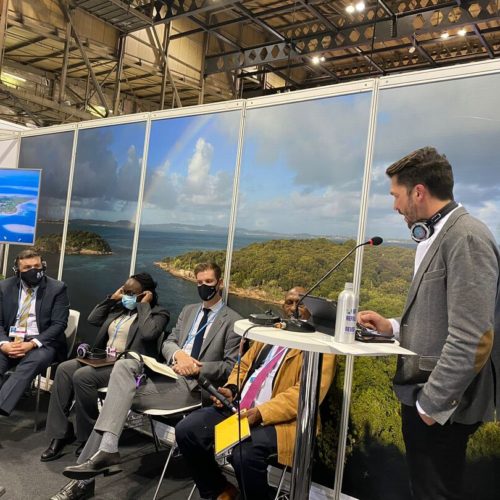
COP26 Keeps 1.5 Degrees in Reach
The UN Climate Change Conference (COP) has historically been a venue for international diplomacy and country-to-country negotiations. Countries were expected to arrive in Glasgow for COP26 with new nationally determined contributions (NDCs, otherwise known as pledges) that would meet the targets under the 2015 Paris Agreement. As in previous years, the negotiations moved from bold ambitions expressed by heads of state at the beginning of the two weeks, to tough and nitty gritty debates about the details in the final days. In the end, significant but not sufficient progress was made. As COP President Alok Sharma said, “The hope for 1.5 degrees stays alive, but its pulse is weak.”
The 1.5 degree target didn’t die thanks to important new commitments on deforestation, methane, coal, and carbon trading as well as the commitment to revise country pledges for 2030 by next year. But the biggest breakthrough in Glasgow, in my mind, came from a completely different angle.
This COP saw more active participation from businesses and financial institutions than any prior climate summit. CEOs showed up in large numbers, having accepted that net zero by 2050 must be their destination. As we like to say at RMI: “The real economy is not a side event.” If there is one thing that inspires hope after Glasgow, and that allows us to call COP26 a success, it is that real actors in the real economy were there to talk about shifting their capital to low-carbon assets.
Not everyone left Glasgow seeing the glass as half full. There was significant frustration from activists, who kept up the pressure on negotiators (and businesses) in a way that deserves respect. Similarly, the least developed and most vulnerable countries were understandably upset by the lack of climate finance delivery and by the failure of the COP to agree on a way to compensate them for the losses and damage already experienced by global warming. There is so much more work to be done.
Here are a few highlights from the two weeks that were COP26:
Governments Increased Ambition
- Some countries improved their pledges, others did not: The UK and EU showed up with materially more ambitious plans in Glasgow while others like South Africa launched new commitments at COP. The United States was back in the game, with an ambitious pledge, but without (for now) the congressional backing embedded in the Build Back Better package. Some other countries showed up without improving their climate ambition at all (Russia, Brazil, Australia). But then, the pledges beyond NDCs rolled out.
- Methane reduction: Over 100 countries representing more than 70 percent of global GDP committed to reducing methane emissions 30 percent by 2030, a breakthrough in climate policy. As a greenhouse gas far more potent than carbon dioxide, rapidly lowering methane emissions is key to limiting more near-term temperature rise. China did not sign up, but committed to the United States to work on methane emissions bilaterally.
- Halting deforestation: More than 100 world leaders pledged to end and reverse deforestation by 2030, covering around 85 percent of the world’s forests. With almost $20 billion of public and private funds and the participation of Brazil and Russia, leaders are optimistic that this pledge will be more successful than a similar 2014 commitment.
- Coal transition: It was watered down at the last-minute to a pledge to“phase down” rather than “phase out” coal power, but it is still significant that coal was mentioned for the first time in a COP text. It falls short of the goal of “consigning coal to history,” but it goes further than the G20 has to date and sends a clear signal. Importantly, several emerging economies made pledges, such as South Africa announcing an $8.5 billion deal to support a transition to clean energy. Our latest report on financing the coal transition describes how this model can work for emerging economies around the world.
- US and China are talking again: The biggest surprise in Glasgow was an agreement by the two biggest emitters to work together. Although there is no big concrete action, it’s good news the pair are at least talking on climate amid a broader diplomatic standoff. China had been all but absent from the talks until this moment.
The Private Sector Showed up—at Scale
- The business presence in Glasgow was enormous: The corporate sector showed up in massive numbers, even if many CEOs were uncertain what precisely they were meant to do. Some compared Glasgow to Davos. RMI delegates met more corporate leaders in 12 days in Glasgow than at all previous COPs combined. In response to fears of corporate greenwashing, the UN Secretary General Antonio Guterres announced a new expert group to assess corporate net-zero claims.
- Finance is mobilizing to align to 1.5 degrees: Former Bank of England Governor Mark Carney cajoled banks, investors, and insurers representing $130 trillion in assets to decarbonize their businesses by mid-century. Finance is a very powerful tool in the fight against climate change, but accountability is still a long way off and the list does not include the world’s three biggest banks, all of which are Chinese.
- Green hydrogen: As just one of many examples of business sector ambition, the Green Hydrogen Catapult set a target for 45 gigawatts of electrolyzers powered with green electricity to be developed with secured financing by 2026, producing enough green hydrogen to power about 45 average-sized steel mills. Along with steel, green hydrogen is a zero-emissions solution that can be used across many industries including shipping and aviation.
- The EV transition is now inevitable: Dozens of governments and car companies from around the world signed up to phase out sales of gasoline and diesel cars within 20 years. The United States, Volkswagen, Renault-Nissan, and Toyota were not part of that pledge, but only the latter because of its fierce resistance to the EV trend.
The UNFCCC Made Practical Progress
- Agreement on carbon trading rules: Hard-won and long-awaited, the rules on international carbon trading bring clarity to companies and standardization that should help reduce emissions, close down some of the outrageous loopholes, and create a structured trading regime between countries. Unfortunately, the language isn’t clear enough to stop companies from gaming the system.
- The Paris rule book is now complete and agreed upon: Measurement, reporting, and verification rules have been agreed on, even if they do not (yet) reflect the latest big data and AI capabilities to identify emissions like ClimateTrace does. Importantly, major emitters must come back next year with more ambitious plans for 2030.
But Work Still Remains
- Climate finance: The developed world failed to deliver on its $100 billion climate finance promise, and COP26 did not fix that. However, parties agreed that by 2025 developed countries need to double their collective funds for adaptation, based on 2019 pledges. This won’t provide the necessary billions for adaptation finance that poorer countries need but is a major improvement on the state of climate finance.
- Global Energy Alliance: Under the leadership of Rockefeller Foundation, a major commitment of $10 billion came together: the Global Energy Alliance for People and Planet, with additional pledges from Ikea Foundation, the Bezos Earth Fund, and various multilateral development banks and development financial institutions. This inspires hope that financial flows can be mobilized beyond governments. RMI will play a significant role in the implementation of GEA’s goals.
- No agreement on loss and damage: For the first time, there’s a formal recognition that countries struck by catastrophic climate events will get help. There is agreement to properly set up a mechanism, although the finer details and exact cash still need to be hashed out, and this is very sensitive particularly for the United States.
One thing is for sure post-COP26: we cannot rest more than a short minute before we resume our work.

